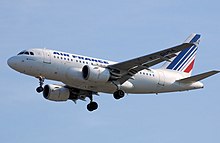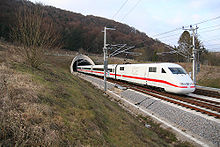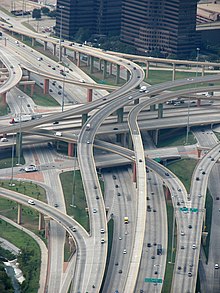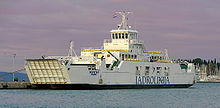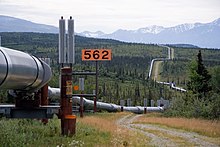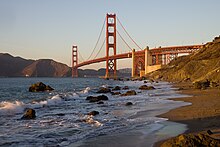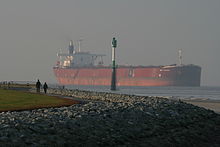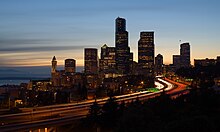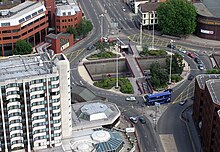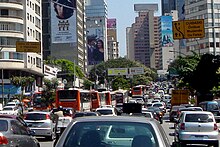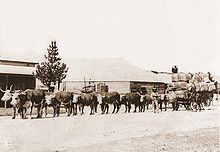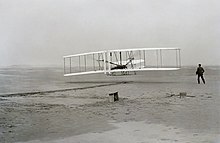
Meaning of TRANSPORTATION in English
[trans.por.ta.tion] n (1540) 1: an act, process, or instance of transporting or being transported
2: banishment to a penal colony 3 a: means of conveyance or travel from one place to another b: public conveyance of passengers or goods esp. as a commercial enterprise — trans.por.ta.tion.al adj
Merriam-Webster English vocab.
Английский словарь Merriam Webster.
2012
транспорт, перевозка, транспортировка, транспортирование
существительное ↓
- перевозка, транспортирование; транспорт
long-distance transportation — дальние перевозки, перевозки на большие расстояния
transportation charges — расходы по перевозке
transportation facilities — перевозочные средства
transportation over water — водная перевозка
means of transportation — средства передвижения; транспортные средства
transportation by air is quick but expensive — самолётом лететь быстро, но дорого
could you give me transportation to the airport? — вы не могли бы доставить меня в аэропорт?
- транспорт, средства сообщения
transportation system — транспортная система /сеть/
urban [public] transportation — городской [общественный] транспорт
- амер. транспортные средства; машины, автомобили
the road was cluttered up with transportation — на дороге образовалось беспорядочное скопление машин
- стоимость перевозки
- билет (на транспорт)
- ссылка (в колонии для преступников)
transportation for life — пожизненная каторга
- перенос (осадочных пород и т. п.)
Мои примеры
Словосочетания
a shambolic system of public transportation — беспорядочная система общественного транспорта 
transportation engineer — инженер транспорта 
to provide transportation — обеспечивать перевозку 
air transportation — воздушная перевозка, транспортировка на самолёте 
bus transportation — автобусная перевозка 
ground / surface transportation — наземный транспорт 
transportation model — модель перевозок 
transportation of dependents — перевозки членов семей военнослужащих 
right to determine the route of transportation — право определения направления перевозки 
transportation documentation — товаросопроводительная документация 
hoists transportation dolly — тележка для перевозки грузоподъёмных средств 
Примеры с переводом
Urban Mass Transportation Administration 
Управление городского общественного транспорта (в США)
The city is working to improve public transportation. 
Городские власти трудятся над улучшением работы общественного транспорта.
Of particular concern is the rising cost of transportation. 
Особую озабоченность вызывает рост затрат на транспортировку.
The sentence was one of transportation for life. 
Приговором стала пожизненная ссылка.
But motorcycle transportation was still a sideline for the company. 
Но перевозка мотоциклов для компании все еще оставалась побочной деятельностью.
The city needs to improve its public transportation (=buses, trains etc). 
Город нуждается в улучшении работы общественного транспорта (т.е. автобусов, поездов и т.д.).
Defense Transportation Administration 
Управление военных перевозок (в США)
ещё 9 примеров свернуть
Примеры, ожидающие перевода
You’ll need to arrange transportation from the airport. 
She arranged for the transportation of her furniture to her new apartment. 
People need to get out of their cars and use other modes of transportation. 
Для того чтобы добавить вариант перевода, кликните по иконке ☰, напротив примера.
Возможные однокоренные слова
2
a
: means of conveyance or travel from one place to another
b
: public conveyance of passengers or goods especially as a commercial enterprise
3
: banishment to a penal colony
transportational
adjective
Synonyms
Example Sentences
the transportation of troops overseas
She arranged for the transportation of her furniture to her new apartment.
He was the U.S. Secretary of Transportation under President Reagan.
Recent Examples on the Web
For more than a decade, the process of collection, transportation and analysis played out several times a year.
—
Indigenous people relied on these bison for their survival and well-being, using bison for myriad purposes, including food, shelter, ceremonies, transportation and weapons.
—
For more than a decade, the process of collection, transportation and analysis played out several times a year.
—
Lukas Petravicius, 40, of the 6100 block of Pinewood Court, Willowbrook, was charged with driving while license revoked, speeding over limit, transportation of alcohol and two DuPage County warrants, at 12:49 a.m. April 2.
—
Whether that eventually winds up increasing the basic allotment or teacher pay, school safety or transportation hasn’t been decided.
—
The number of strikers in key sectors like transportation and education has also slowly declined.
—
In May 2014, Seminole voters approved bumping up the sales tax in the county from 6 cents on the dollar to 7 cents for 10 years to pay for construction of school facilities, stormwater infrastructure and transportation projects — such as roads and trails.
—
Students face thousands of dollars in other costs, including fees, books, food, housing and transportation.
—
See More
These examples are programmatically compiled from various online sources to illustrate current usage of the word ‘transportation.’ Any opinions expressed in the examples do not represent those of Merriam-Webster or its editors. Send us feedback about these examples.
Word History
First Known Use
1540, in the meaning defined at sense 1
Time Traveler
The first known use of transportation was
in 1540
Dictionary Entries Near transportation
Cite this Entry
“Transportation.” Merriam-Webster.com Dictionary, Merriam-Webster, https://www.merriam-webster.com/dictionary/transportation. Accessed 14 Apr. 2023.
Share
More from Merriam-Webster on transportation
Last Updated:
13 Apr 2023
— Updated example sentences
Subscribe to America’s largest dictionary and get thousands more definitions and advanced search—ad free!
Merriam-Webster unabridged
-
1
transportation
transportation n
транспортировка
Air Transportation Board
Комитет по воздушным перевозкам
alternate transportation
резервное транспортное средство
bulk transportation
смешанная перевозка
collect transportation
перевозка с оплатой в кредит
commercial air transportation
коммерческая воздушная перевозка
Department of Transportation
Министерство транспорта
interline transportation
совместная перевозка нескольких авиалиний
prepaid transportation
перевозка с предварительной оплатой
short-haul transportation
местная перевозка
unit toll transportation
перевозка по специальному тарифу
English-Russian aviation dictionary > transportation
-
2
transportation
Англо-русский словарь строительных терминов > transportation
-
3
transportation
transportation [ˏtrænspɔ:ˊteɪʃn]
n
1) перево́зка, тра́нспорт; транспорти́рование
2)
амер.
тра́нспортные сре́дства
3)
амер.
сто́имость перево́зки
4)
амер.
биле́т (железнодорожный, трамвайный
и т.п.
)
5)
ист.
ссы́лка на ка́торгу
Англо-русский словарь Мюллера > transportation
-
4
transportation
Персональный Сократ > transportation
-
5
transportation
English-russian dctionary of contemporary Economics > transportation
-
6
transportation
транспорт; транспортные средства; транспортирование, перевозки; транспортное обеспечение; транспортный
English-Russian military dictionary > transportation
-
7
transportation
1. n перевозка, транспортирование; транспорт
2. n транспорт, средства сообщения
3. n амер. транспортные средства; машины, автомобили
4. n амер. стоимость перевозки
5. n амер. билет
6. n амер. ссылка
7. n амер. перенос
Синонимический ряд:
transit (noun) carriage; carrying; conveyance; hauling; movement; moving; transferral; transit; transport; transporting; vehicle
English-Russian base dictionary > transportation
-
8
transportation
[ˌtrænspɔ:ˈteɪʃən]
freight transportation грузовой транспорт goods transportation грузовые перевозки goods transportation перевозка товаров long-distance freight transportation грузовые перевозки на дальние расстояния passenger transportation пассажирские перевозки passenger transportation пассажирский транспорт piggy-back transportation контрейлерные перевозки piggy-back transportation перевозка автоприцепов с грузами автомобильным и железнодорожным транспортом transportation амер. билет (железнодорожный, трамвайный и т. п.) transportation перевозка, транспорт; транспортирование transportation перевозка transportation ист. ссылка на каторгу transportation стоимость перевозки transportation амер. стоимость перевозки transportation транспорт transportation транспортирование transportation транспортные средства transportation of goods грузовые перевозки transportation of goods перевозка грузов transportation to your home доставка на дом
English-Russian short dictionary > transportation
-
9
transportation
Англо-русский словарь нефтегазовой промышленности > transportation
-
10
transportation
Англо-русский технический словарь > transportation
-
11
transportation
[͵trænspɔ:ʹteıʃ(ə)n]
1. перевозка, транспортирование; транспорт
long-distance transportation — дальние перевозки, перевозки на большие расстояния
means of transportation — транспортные средства, средства сообщения
transportation by air is quick but expensive — самолётом лететь быстро, но дорого
could you give me transportation to the airport? — вы не могли бы доставить меня в аэропорт?
2. транспорт, средства сообщения
transportation system — транспортная система /сеть/
urban [public] transportation — городской [общественный] транспорт
3.
транспортные средства; машины, автомобили
the road was cluttered up with transportation — на дороге образовалось беспорядочное скопление машин
1) стоимость перевозки
6. перенос ()
НБАРС > transportation
-
12
transportation
1) транспорт(ировка), перевозка
4) перенос; перемещение
•
Англо-русский словарь технических терминов > transportation
-
13
transportation
перенос, перемещение
transportation by ice перенос льдом
transportation by rain wash перенос дождевыми водами
transportation by streams перенос речными потоками
transportation by traction перенос волочением [передвижением по дну]
transportation by water перенос водой
transportation in standing bodies of water перенос в стоячих водах
transportation through action of gravity перенос под действием силы тяжести
transportation through changes of temperature перенос под действием перемен температуры
transportation of sediments перенос осадков
transportation of sediments by organisms перенос осадков организмами
stream transportation перенос речными потоками* * *
English-Russian dictionary of geology > transportation
-
14
transportation
сущ.
1)
общ.
перевозка, транспортировка
See:
2)
общ.
транспортные средства; транспорт; средства сообщения
See:
3)
а)
,
амер.
стоимость перевозки
* * *
транспортировка, перевозка товаров.* * *
* * *
Международные перевозки/Таможенное право
Англо-русский экономический словарь > transportation
-
15
transportation
Англо-русский синонимический словарь > transportation
-
16
transportation
1. транспортировка; перевозка
Англо-русский словарь по гражданской авиации > transportation
-
17
transportation
Politics english-russian dictionary > transportation
-
18
transportation
Англо-русский словарь по машиностроению > transportation
-
19
transportation
1) перевозка, транспортировка, транспортирование, доставка
2) транспорт; транспортное средство
•
English-Russian scientific dictionary > transportation
-
20
transportation
перевозка, транспортировка
Englsh-Russian aviation and space dictionary > transportation
Страницы
- Следующая →
- 1
- 2
- 3
- 4
- 5
- 6
- 7
См. также в других словарях:
-
transportation — trans‧por‧ta‧tion [ˌtrænspɔːˈteɪʆn ǁ spər ] noun [uncountable] 1. TRANSPORT the process or business of moving goods from one place to another by rail, air, ship etc: • Prices include transportation from London. 2. TRANSPORT … Financial and business terms
-
transportation — [ trɑ̃spɔrtasjɔ̃ ] n. f. • av. 1778; h. 1519; lat. transportatio « émigration » 1 ♦ Vx Déportation, exil forcé (d un peuple, d un groupe). 2 ♦ Dr. Institution par laquelle les condamnés aux travaux forcés étaient transportés dans une colonie pour … Encyclopédie Universelle
-
Transportation — Trans por*ta tion, n. [L. transportatio: cf. F. transportation.] 1. The act of transporting, or the state of being transported; carriage from one place to another; removal; conveyance. [1913 Webster] To provide a vessel for their transportation.… … The Collaborative International Dictionary of English
-
transportation — index carriage, removal, transmittal Burton s Legal Thesaurus. William C. Burton. 2006 transportation … Law dictionary
-
Transportation — (lat.), überseeische Verschickung verurteilter Verbrecher. Im weitern Sinn also soviel wie Deportation; im engern Sinne des neuern französischen Rechts von dieser wie von der Relegation unterschieden. S. Deportation … Meyers Großes Konversations-Lexikon
-
Transportation — (lat.), s.v.w. Deportation … Kleines Konversations-Lexikon
-
transportation — 1530s, act of transporting, noun of action from TRANSPORT (Cf. transport). In the sense of means of conveyance it is first recorded 1853 … Etymology dictionary
-
transportation — [trans΄pər tā′shən, trans΄pôrtā′shən] n. [Fr < L transportatio] 1. a transporting or being transported 2. ☆ a) a means or system of conveyance b) the work or business of conveying passengers or goods ☆ 3. fare or a ticket for being transported … English World dictionary
-
transportation — /trans peuhr tay sheuhn/, n. 1. the act of transporting. 2. the state of being transported. 3. the means of transport or conveyance. 4. the business of conveying people, goods, etc. 5. price of travel or transport by public conveyance; fare. 6.… … Universalium
-
transportation — noun (esp. AmE) ⇨ See also ↑transit, ↑transport ADJECTIVE ▪ mass, public ▪ Many destinations can be reached by public transportation. ▪ private ▪ … Collocations dictionary
-
transportation — n. (esp. AE; BE usu. has transport) 1) to provide transportation 2) air; bus; ground, surface; mass, public transportation 3) transportation from; to (to provide transportation from the city to the airport) * * * [ˌtrænspɔː teɪʃ(ə)n] bus ground… … Combinatory dictionary
Transport (in British English), or transportation (in American English), is the intentional movement of humans, animals, and goods from one location to another. Modes of transport include air, land (rail and road), water, cable, pipeline, and space. The field can be divided into infrastructure, vehicles, and operations. Transport enables human trade, which is essential for the development of civilizations.
Transport infrastructure consists of both fixed installations, including roads, railways, airways, waterways, canals, and pipelines, and terminals such as airports, railway stations, bus stations, warehouses, trucking terminals, refueling depots (including fueling docks and fuel stations), and seaports. Terminals may be used both for interchange of passengers and cargo and for maintenance.
Means of transport are any of the different kinds of transport facilities used to carry people or cargo. They may include vehicles, riding animals, and pack animals. Vehicles may include wagons, automobiles, bicycles, buses, trains, trucks, helicopters, watercraft, spacecraft, and aircraft.
Modes[edit]
Various modes of transport
A mode of transport is a solution that makes use of a certain type of vehicle, infrastructure, and operation. The transport of a person or of cargo may involve one mode or several of the modes, with the latter case being called inter-modal or multi-modal transport. Each mode has its own advantages and disadvantages, and will be chosen on the basis of cost, capability, and route.
Governments deal with the way the vehicles are operated, and the procedures set for this purpose, including financing, legalities, and policies. In the transport industry, operations and ownership of infrastructure can be either public or private, depending on the country and mode.
Passenger transport may be public, where operators provide scheduled services, or private. Freight transport has become focused on containerization, although bulk transport is used for large volumes of durable items. Transport plays an important part in economic growth and globalization, but most types cause air pollution and use large amounts of land. While it is heavily subsidized by governments, good planning of transport is essential to make traffic flow and restrain urban sprawl.
Human-powered[edit]
Human-powered transport, a form of sustainable transport, is the transport of people and/or goods using human muscle-power, in the form of walking, running, and swimming. Modern technology has allowed machines to enhance human power. Human-powered transport remains popular for reasons of cost-saving, leisure, physical exercise, and environmentalism; it is sometimes the only type available, especially in underdeveloped or inaccessible regions.
Although humans are able to walk without infrastructure, the transport can be enhanced through the use of roads, especially when using the human power with vehicles, such as bicycles and inline skates. Human-powered vehicles have also been developed for difficult environments, such as snow and water, by watercraft rowing and skiing; even the air can be entered with human-powered aircraft.
Animal-powered[edit]
Animal-powered transport is the use of working animals for the movement of people and commodities. Humans may ride some of the animals directly, use them as pack animals for carrying goods, or harness them, alone or in teams, to pull sleds or wheeled vehicles.
Air[edit]
A fixed-wing aircraft, commonly called an airplane, is a heavier-than-air craft where movement of the air in relation to the wings is used to generate lift. The term is used to distinguish this from rotary-wing aircraft, where the movement of the lift surfaces relative to the air generates lift. A gyroplane is both fixed-wing and rotary wing. Fixed-wing aircraft range from small trainers and recreational aircraft to large airliners and military cargo aircraft.
Two things necessary for aircraft are air flow over the wings for lift and an area for landing. The majority of aircraft also need an airport with the infrastructure for maintenance, restocking, and refueling and for the loading and unloading of crew, cargo, and passengers.[1] While the vast majority of aircraft land and take off on land, some are capable of take-off and landing on ice, snow, and calm water.
The aircraft is the second fastest method of transport, after the rocket. Commercial jets can reach up to 955 kilometres per hour (593 mph), single-engine aircraft 555 kilometres per hour (345 mph). Aviation is able to quickly transport people and limited amounts of cargo over longer distances, but incurs high costs and energy use; for short distances or in inaccessible places, helicopters can be used.[2] As of April 28, 2009, The Guardian article notes that «the WHO estimates that up to 500,000 people are on planes at any time.»[3]
Land[edit]
Land transport covers all land-based transport systems that provide for the movement of people, goods, and services. Land transport plays a vital role in linking communities to each other. Land transport is a key factor in urban planning. It consists of two kinds, rail and road.
Rail[edit]
The Beijing Subway is one of the world’s largest and busiest rapid transit networks.
Rail transport is where a train runs along a set of two parallel steel rails, known as a railway or railroad. The rails are anchored perpendicular to ties (or sleepers) of timber, concrete, or steel, to maintain a consistent distance apart, or gauge. The rails and perpendicular beams are placed on a foundation made of concrete or compressed earth and gravel in a bed of ballast. Alternative methods include monorail and maglev.
A train consists of one or more connected vehicles that operate on the rails. Propulsion is commonly provided by a locomotive, that hauls a series of unpowered cars, that can carry passengers or freight. The locomotive can be powered by steam, by diesel, or by electricity supplied by trackside systems. Alternatively, some or all the cars can be powered, known as a multiple unit. Also, a train can be powered by horses, cables, gravity, pneumatics, and gas turbines. Railed vehicles move with much less friction than rubber tires on paved roads, making trains more energy efficient, though not as efficient as ships.
Intercity trains are long-haul services connecting cities;[4] modern high-speed rail is capable of speeds up to 350 km/h (220 mph), but this requires specially built track. Regional and commuter trains feed cities from suburbs and surrounding areas, while intra-urban transport is performed by high-capacity tramways and rapid transits, often making up the backbone of a city’s public transport. Freight trains traditionally used box cars, requiring manual loading and unloading of the cargo. Since the 1960s, container trains have become the dominant solution for general freight, while large quantities of bulk are transported by dedicated trains.
Road[edit]
A road is an identifiable route, way, or path between two or more places.[5] Roads are typically smoothed, paved, or otherwise prepared to allow easy travel;[6] though they need not be, and historically many roads were simply recognizable routes without any formal construction or maintenance.[7] In urban areas, roads may pass through a city or village and be named as streets, serving a dual function as urban space easement and route.[8]
The most common road vehicle is the automobile; a wheeled passenger vehicle that carries its own motor. Other users of roads include buses, trucks, motorcycles, bicycles, and pedestrians. As of 2010, there were 1.015 billion automobiles worldwide.
Road transport offers complete freedom to road users to transfer the vehicle from one lane to the other and from one road to another according to the need and convenience. This flexibility of changes in location, direction, speed, and timings of travel is not available to other modes of transport. It is possible to provide door-to-door service only by road transport.
Automobiles provide high flexibility with low capacity, but require high energy and area use, and are the main source of harmful noise and air pollution in cities;[9] buses allow for more efficient travel at the cost of reduced flexibility.[4] Road transport by truck is often the initial and final stage of freight transport.
Water[edit]
Water transport is movement by means of a watercraft—such as a barge, boat, ship, or sailboat—over a body of water, such as a sea, ocean, lake, canal, or river. The need for buoyancy is common to watercraft, making the hull a dominant aspect of its construction, maintenance, and appearance.
In the 19th century, the first steam ships were developed, using a steam engine to drive a paddle wheel or propeller to move the ship. The steam was produced in a boiler using wood or coal and fed through a steam external combustion engine. Now most ships have an internal combustion engine using a slightly refined type of petroleum called bunker fuel. Some ships, such as submarines, use nuclear power to produce the steam. Recreational or educational craft still use wind power, while some smaller craft use internal combustion engines to drive one or more propellers or, in the case of jet boats, an inboard water jet. In shallow draft areas, hovercraft are propelled by large pusher-prop fans. (See Marine propulsion.)
Although it is slow compared to other transport, modern sea transport is a highly efficient method of transporting large quantities of goods. Commercial vessels, nearly 35,000 in number, carried 7.4 billion tons of cargo in 2007.[10] Transport by water is significantly less costly than air transport for transcontinental shipping;[11] short sea shipping and ferries remain viable in coastal areas.[12][13]
Other modes[edit]
Pipeline transport sends goods through a pipe; most commonly liquid and gases are sent, but pneumatic tubes can also send solid capsules using compressed air. For liquids/gases, any chemically stable liquid or gas can be sent through a pipeline. Short-distance systems exist for sewage, slurry, water, and beer, while long-distance networks are used for petroleum and natural gas.
Cable transport is a broad mode where vehicles are pulled by cables instead of an internal power source. It is most commonly used at steep gradient. Typical solutions include aerial tramways, elevators, and ski lifts; some of these are also categorized as conveyor transport.
Spaceflight is transport out of Earth’s atmosphere into outer space by means of a spacecraft. While large amounts of research have gone into technology, it is rarely used except to put satellites into orbit and conduct scientific experiments. However, man has landed on the moon, and probes have been sent to all the planets of the Solar System.
Suborbital spaceflight is the fastest of the existing and planned transport systems from a place on Earth to a distant «other place» on Earth. Faster transport could be achieved through part of a low Earth orbit or by following that trajectory even faster, using the propulsion of the rocket to steer it.
Elements[edit]
Infrastructure[edit]
Tunnels, such as the Tampere Tunnel, allow traffic to pass underground or through rock formations.
Infrastructure is the fixed installations that allow a vehicle to operate. It consists of a roadway, a terminal, and facilities for parking and maintenance. For rail, pipeline, road, and cable transport, the entire way the vehicle travels must be constructed. Air and watercraft are able to avoid this, since the airway and seaway do not need to be constructed. However, they require fixed infrastructure at terminals.
Terminals such as airports, ports, and stations, are locations where passengers and freight can be transferred from one vehicle or mode to another. For passenger transport, terminals are integrating different modes to allow riders, who are interchanging between modes, to take advantage of each mode’s benefits. For instance, airport rail links connect airports to the city centres and suburbs. The terminals for automobiles are parking lots, while buses and coaches can operate from simple stops.[14] For freight, terminals act as transshipment points, though some cargo is transported directly from the point of production to the point of use.
The financing of infrastructure can either be public or private. Transport is often a natural monopoly and a necessity for the public; roads, and in some countries railways and airports, are funded through taxation. New infrastructure projects can have high costs and are often financed through debt. Many infrastructure owners, therefore, impose usage fees, such as landing fees at airports or toll plazas on roads. Independent of this, authorities may impose taxes on the purchase or use of vehicles. Because of poor forecasting and overestimation of passenger numbers by planners, there is frequently a benefits shortfall for transport infrastructure projects.[15]
Means of transport[edit]
Animals[edit]
Animals used in transportation include pack animals and riding animals.
Vehicles[edit]
A vehicle is a non-living device that is used to move people and goods. Unlike the infrastructure, the vehicle moves along with the cargo and riders. Unless being pulled/pushed by a cable or muscle-power, the vehicle must provide its own propulsion; this is most commonly done through a steam engine, combustion engine, electric motor, jet engine, or rocket, though other means of propulsion also exist. Vehicles also need a system of converting the energy into movement; this is most commonly done through wheels, propellers, and pressure.
Vehicles are most commonly staffed by a driver. However, some systems, such as people movers and some rapid transits, are fully automated. For passenger transport, the vehicle must have a compartment, seat, or platform for the passengers. Simple vehicles, such as automobiles, bicycles, or simple aircraft, may have one of the passengers as a driver. Recently, the progress related to the Fourth Industrial Revolution has brought a lot of new emerging technologies for transportation and automotive fields such as Connected Vehicles and Autonomous Driving. These innovations are said to form future mobility, but concerns remain on safety and cybersecurity, particularly concerning connected and autonomous mobility. [16]
Operation[edit]
Private transport is only subject to the owner of the vehicle, who operates the vehicle themselves. For public transport and freight transport, operations are done through private enterprise or by governments. The infrastructure and vehicles may be owned and operated by the same company, or they may be operated by different entities. Traditionally, many countries have had a national airline and national railway. Since the 1980s, many of these have been privatized. International shipping remains a highly competitive industry with little regulation,[17] but ports can be public-owned.[18]
Policy[edit]
|
|
This section is missing information about most of what constitutes official traffic management and planning, how it integrates with other fields of politics and how it is enforced. Please expand the section to include this information. Further details may exist on the talk page. (December 2021) |
As the population of the world increases, cities grow in size and population—according to the United Nations, 55% of the world’s population live in cities, and by 2050 this number is expected to rise to 68%.[19] Public transport policy must evolve to meet the changing priorities of the urban world.[20] The institution of policy enforces order in transport, which is by nature chaotic as people attempt to travel from one place to another as fast as possible. This policy helps to reduce accidents and save lives.
Functions[edit]
Relocation of travelers and cargo are the most common uses of transport. However, other uses exist, such as the strategic and tactical relocation of armed forces during warfare, or the civilian mobility construction or emergency equipment.
Passenger[edit]
Passenger transport, or travel, is divided into public and private transport. Public transport is scheduled services on fixed routes, while private is vehicles that provide ad hoc services at the riders desire. The latter offers better flexibility, but has lower capacity and a higher environmental impact. Travel may be as part of daily commuting or for business, leisure, or migration.
Short-haul transport is dominated by the automobile and mass transit. The latter consists of buses in rural and small cities, supplemented with commuter rail, trams, and rapid transit in larger cities. Long-haul transport involves the use of the automobile, trains, coaches, and aircraft, the last of which have become predominantly used for the longest, including intercontinental, travel. Intermodal passenger transport is where a journey is performed through the use of several modes of transport; since all human transport normally starts and ends with walking, all passenger transport can be considered intermodal. Public transport may also involve the intermediate change of vehicle, within or across modes, at a transport hub, such as a bus or railway station.
Taxis and buses can be found on both ends of the public transport spectrum. Buses are the cheapest mode of transport but are not necessarily flexible, and taxis are very flexible but more expensive. In the middle is demand-responsive transport, offering flexibility whilst remaining affordable.
International travel may be restricted for some individuals due to legislation and visa requirements.
Medical[edit]
An ambulance from World War I
An ambulance is a vehicle used to transport people from or between places of treatment,[21] and in some instances will also provide out-of-hospital medical care to the patient. The word is often associated with road-going «emergency ambulances», which form part of emergency medical services, administering emergency care to those with acute medical problems.
Air medical services is a comprehensive term covering the use of air transport to move patients to and from healthcare facilities and accident scenes. Personnel provide comprehensive prehospital and emergency and critical care to all types of patients during aeromedical evacuation or rescue operations, aboard helicopters, propeller aircraft, or jet aircraft.[22][23]
Freight[edit]
Freight transport, or shipping, is a key in the value chain in manufacturing.[24] With increased specialization and globalization, production is being located further away from consumption, rapidly increasing the demand for transport.[25] Transport creates place utility by moving the goods from the place of production to the place of consumption.[26] While all modes of transport are used for cargo transport, there is high differentiation between the nature of the cargo transport, in which mode is chosen.[27] Logistics refers to the entire process of transferring products from producer to consumer, including storage, transport, transshipment, warehousing, material-handling, and packaging, with associated exchange of information.[28] Incoterm deals with the handling of payment and responsibility of risk during transport.[29]
Containerization, with the standardization of ISO containers on all vehicles and at all ports, has revolutionized international and domestic trade, offering a huge reduction in transshipment costs. Traditionally, all cargo had to be manually loaded and unloaded into the haul of any ship or car; containerization allows for automated handling and transfer between modes, and the standardized sizes allow for gains in economy of scale in vehicle operation. This has been one of the key driving factors in international trade and globalization since the 1950s.[30]
Bulk transport is common with cargo that can be handled roughly without deterioration; typical examples are ore, coal, cereals, and petroleum. Because of the uniformity of the product, mechanical handling can allow enormous quantities to be handled quickly and efficiently. The low value of the cargo combined with high volume also means that economies of scale become essential in transport, and gigantic ships and whole trains are commonly used to transport bulk. Liquid products with sufficient volume may also be transported by pipeline.
Air freight has become more common for products of high value; while less than one percent of world transport by volume is by airline, it amounts to forty percent of the value. Time has become especially important in regards to principles such as postponement and just-in-time within the value chain, resulting in a high willingness to pay for quick delivery of key components or items of high value-to-weight ratio.[31] In addition to mail, common items sent by air include electronics and fashion clothing.
Industry[edit]
Impact[edit]
Economic[edit]
Transport is a key component of growth and globalization, such as in Seattle, Washington, United States.
Transport is a key necessity for specialization—allowing production and consumption of products to occur at different locations. Throughout history, transport has been a spur to expansion; better transport allows more trade and a greater spread of people. Economic growth has always been dependent on increasing the capacity and rationality of transport.[32] But the infrastructure and operation of transport have a great impact on the land, and transport is the largest drainer of energy, making transport sustainability a major issue.
Due to the way modern cities and communities are planned and operated, a physical distinction between home and work is usually created, forcing people to transport themselves to places of work, study, or leisure, as well as to temporarily relocate for other daily activities. Passenger transport is also the essence of tourism, a major part of recreational transport. Commerce requires the transport of people to conduct business, either to allow face-to-face communication for important decisions or to move specialists from their regular place of work to sites where they are needed.
In lean thinking, transporting materials or work in process from one location to another is seen as one of the seven wastes (Japanese term: muda) which do not add value to a product.[33]
Planning[edit]
Transport planning allows for high utilization and less impact regarding new infrastructure. Using models of transport forecasting, planners are able to predict future transport patterns. On the operative level, logistics allows owners of cargo to plan transport as part of the supply chain. Transport as a field is also studied through transport economics, a component for the creation of regulation policy by authorities. Transport engineering, a sub-discipline of civil engineering, must take into account trip generation, trip distribution, mode choice, and route assignment, while the operative level is handled through traffic engineering.
The engineering of this roundabout in Bristol, United Kingdom, attempts to make traffic flow free-moving.
Because of the negative impacts incurred, transport often becomes the subject of controversy related to choice of mode, as well as increased capacity. Automotive transport can be seen as a tragedy of the commons, where the flexibility and comfort for the individual deteriorate the natural and urban environment for all. Density of development depends on mode of transport, with public transport allowing for better spatial utilization. Good land use keeps common activities close to people’s homes and places higher-density development closer to transport lines and hubs, to minimize the need for transport. There are economies of agglomeration. Beyond transport, some land uses are more efficient when clustered. Transport facilities consume land, and in cities pavement (devoted to streets and parking) can easily exceed 20 percent of the total land use. An efficient transport system can reduce land waste.
Too much infrastructure and too much smoothing for maximum vehicle throughput mean that in many cities there is too much traffic and many—if not all—of the negative impacts that come with it. It is only in recent years that traditional practices have started to be questioned in many places; as a result of new types of analysis which bring in a much broader range of skills than those traditionally relied on—spanning such areas as environmental impact analysis, public health, sociology, and economics—the viability of the old mobility solutions is increasingly being questioned.
Environment[edit]
Transport is a major use of energy and burns most of the world’s petroleum. This creates air pollution, including nitrous oxides and particulates, and is a significant contributor to global warming through emission of carbon dioxide,[35] for which transport is the fastest-growing emission sector.[36] By sub-sector, road transport is the largest contributor to global warming.[37] Environmental regulations in developed countries have reduced individual vehicles’ emissions; however, this has been offset by increases in the numbers of vehicles and in the use of each vehicle.[35] Some pathways to reduce the carbon emissions of road vehicles considerably have been studied.[38][39] Energy use and emissions vary largely between modes, causing environmentalists to call for a transition from air and road to rail and human-powered transport, as well as increased transport electrification and energy efficiency.
Other environmental impacts of transport systems include traffic congestion and automobile-oriented urban sprawl, which can consume natural habitat and agricultural lands. By reducing transport emissions globally, it is predicted that there will be significant positive effects on Earth’s air quality, acid rain, smog, and climate change.[40]
While electric cars are being built to cut down CO2 emission at the point of use, an approach that is becoming popular among cities worldwide is to prioritize public transport, bicycles, and pedestrian movement. Redirecting vehicle movement to create 20-minute neighbourhoods[41] that promotes exercise while greatly reducing vehicle dependency and pollution. Some policies are levying a congestion charge[42] to cars for travelling within congested areas during peak time.
Sustainable development[edit]
The United Nations first formally recognized the role of transport in sustainable development in the 1992 United Nations Earth summit. In the 2012 United Nations World Conference, global leaders unanimously recognized that transport and mobility are central to achieving the sustainability targets. In recent years, data has been collected to show that the transport sector contributes to a quarter of the global greenhouse gas emissions, and therefore sustainable transport has been mainstreamed across several of the 2030 Sustainable Development Goals, especially those related to food, security, health, energy, economic growth, infrastructure, and cities and human settlements. Meeting sustainable transport targets is said to be particularly important to achieving the Paris Agreement.[43]
There are various Sustainable Development Goals (SDGs) that are promoting sustainable transport in order to meet the defined goals. These include SDG 3 on health (increased road safety), SDG 7 on energy, SDG 8 on decent work and economic growth, SDG 9 on resilient infrastructure, SDG 11 on sustainable cities (access to transport and expanded public transport), SDG 12 on sustainable consumption and production (ending fossil fuel subsidies), and SDG 14 on oceans, seas, and marine resources.[44]
History[edit]
Natural[edit]
Humans’ first ways to move included walking, running, and swimming. The domestication of animals introduced a new way to lay the burden of transport on more powerful creatures, allowing the hauling of heavier loads, or humans riding animals for greater speed and duration. Inventions such as the wheel and the sled (U.K. sledge) helped make animal transport more efficient through the introduction of vehicles.
The first forms of road transport involved animals, such as horses (domesticated in the 4th or the 3rd millennium BCE), oxen (from about 8000 BCE),[45] or humans carrying goods over dirt tracks that often followed game trails.
Infrastructure[edit]
Many early civilizations, including those in Mesopotamia and the Indus Valley, constructed paved roads. In classical antiquity, the Persian and Roman empires built stone-paved roads to allow armies to travel quickly. Deep roadbeds of crushed stone underneath kept such roads dry. The medieval Caliphate later built tar-paved roads.
Water transport[edit]
Water transport, including rowed and sailed vessels, dates back to time immemorial and was the only efficient way to transport large quantities or over large distances prior to the Industrial Revolution. The first watercraft were canoes cut out from tree trunks. Early water transport was accomplished with ships that were either rowed or used the wind for propulsion, or a combination of the two. The importance of water has led to most cities that grew up as sites for trading being located on rivers or on the sea-shore, often at the intersection of two bodies of water.
Mechanical[edit]
Until the Industrial Revolution, transport remained slow and costly, and production and consumption gravitated as close to each other as feasible.[citation needed] The Industrial Revolution in the 19th century saw several inventions fundamentally change transport. With telegraphy, communication became instant and independent of the transport of physical objects. The invention of the steam engine, closely followed by its application in rail transport, made land transport independent of human or animal muscles. Both speed and capacity increased, allowing specialization through manufacturing being located independently of natural resources. The 19th century also saw the development of the steam ship, which sped up global transport.
With the development of the combustion engine and the automobile around 1900, road transport became more competitive again, and mechanical private transport originated. The first «modern» highways were constructed during the 19th century[citation needed] with macadam. Later, tarmac and concrete became the dominant paving materials.
In 1903 the Wright brothers demonstrated the first successful controllable airplane, and after World War I (1914–1918) aircraft became a fast way to transport people and express goods over long distances.[46]
After World War II (1939–1945) the automobile and airlines took higher shares of transport, reducing rail and water to freight and short-haul passenger services.[47] Scientific spaceflight began in the 1950s, with rapid growth until the 1970s, when interest dwindled. In the 1950s the introduction of containerization gave massive efficiency gains in freight transport, fostering globalization.[30] International air travel became much more accessible in the 1960s with the commercialization of the jet engine. Along with the growth in automobiles and motorways, rail and water transport declined in relative importance. After the introduction of the Shinkansen in Japan in 1964, high-speed rail in Asia and Europe started attracting passengers on long-haul routes away from the airlines.[47]
Early in U.S. history,[when?] private joint-stock corporations owned most aqueducts, bridges, canals, railroads, roads, and tunnels. Most such transport infrastructure came under government control in the late 19th and early 20th centuries, culminating in the nationalization of inter-city passenger rail-service with the establishment of Amtrak. Recently,[when?] however, a movement to privatize roads and other infrastructure has gained some[quantify] ground and adherents.[48]
See also[edit]
- Environmental impact of aviation
- Energy efficiency in transport
- Green transport hierarchy
- IEEE Intelligent Transportation Systems Society
- List of emerging transportation technologies
- Journal of Transport and Land Use
- Outline of transport
- Public transport
- Rail transport by country
- Speed record
- Taxicabs by country
- Transportation engineering
References[edit]
- ^ Crawford, Amy (2021-10-25). «Could flying electric ‘air taxis’ help fix urban transportation?». The Guardian. Archived from the original on 2021-11-19. Retrieved 2021-11-19.
- ^ Cooper & Shepherd 1998, p. 281.
- ^ Swine flu prompts EU warning on travel to US Archived 2015-09-26 at the Wayback Machine. The Guardian. April 28, 2009.
- ^ a b Cooper & Shepherd 1998, p. 279.
- ^ «Major Roads of the United States». United States Department of the Interior. 2006-03-13. Archived from the original on 13 April 2007. Retrieved 24 March 2007.
- ^ «Road Infrastructure Strategic Framework for South Africa». National Department of Transport (South Africa). Archived from the original on 27 September 2007. Retrieved 24 March 2007.
- ^ Lay 1992, pp. 6–7.
- ^ «What is the difference between a road and a street?». Word FAQ. Lexico Publishing Group. 2007. Archived from the original on 5 April 2007. Retrieved 24 March 2007.
- ^ Harvey, Fiona (2020-03-05). «One in five Europeans exposed to harmful noise pollution – study». The Guardian. ISSN 0261-3077. Archived from the original on 2020-03-05. Retrieved 2020-03-05.
- ^ The United Nations Conference on Trade and Development (UNCTAD) 2007, p. x and p. 32.
- ^ Stopford 1997, pp. 4–6.
- ^ Stopford 1997, pp. 8–9.
- ^ Cooper & Shepherd 1998, p. 280.
- ^ Cooper & Shepherd 1998, pp. 275–76.
- ^ Bent Flyvbjerg, Mette K. Skamris Holm, and Søren L. Buhl, «How (In)Accurate Are Demand Forecasts in Public Works Projects», Journal of the American Planning Association 71:2, pp. 131–46.
- ^ Hamid, Umar Zakir Abdul; et al. (2021). «Facilitating a Reliable, Feasible, and Comfortable Future Mobility». SAE International Journal of Connected and Automated Vehicles. 4 (1). Retrieved 5 September 2022.
- ^ Stopford 1997, p. 422.
- ^ Stopford 1997, p. 29.
- ^ Meredith, Sam (2018-05-17). «Two-thirds of global population will live in cities by 2050, UN says». CNBC. Archived from the original on 2020-11-12. Retrieved 2018-11-20.
- ^ Jones, Peter (July 2014). «The evolution of urban mobility: The interplay of academic and policy perspectives». IATSS Research. 38: 7–13. doi:10.1016/j.iatssr.2014.06.001.
- ^ Skinner, Henry Alan. 1949, «The Origin of Medical Terms». Baltimore: Williams & Wilkins
- ^ Branas CC, MacKenzie EJ, Williams JC, Schwab CW, Teter HM, Flanigan MC, et al. (2005). «Access to trauma centers in the United States». JAMA. 293 (21): 2626–33. doi:10.1001/jama.293.21.2626. PMID 15928284.
- ^ Burney RE, Hubert D, Passini L, Maio R (1995). «Variation in air medical outcomes by crew composition: a two-year follow-up». Ann Emerg Med. 25 (2): 187–92. doi:10.1016/s0196-0644(95)70322-5. PMID 7832345.
- ^ Chopra & Meindl 2007, p. 3.
- ^ Chopra & Meindl 2007, pp. 63–64.
- ^ McLeod, Sam; Curtis, Carey (2020-03-14). «Understanding and Planning for Freight Movement in Cities: Practices and Challenges». Planning Practice & Research. 35 (2): 201–219. doi:10.1080/02697459.2020.1732660. ISSN 0269-7459. S2CID 214463529. Archived from the original on 2022-07-30. Retrieved 2021-01-14.
- ^ Chopra & Meindl 2007, p. 54.
- ^ Bardi, Coyle & Novack 2006, p. 4.
- ^ Bardi, Coyle & Novack 2006, p. 473.
- ^ a b Bardi, Coyle & Novack 2006, pp. 211–214.
- ^ Chopra & Meindl 2007, p. 328.
- ^ Stopford 1997, p. 2.
- ^ EKU Online, The Seven Wastes of Lean Manufacturing, Eastern Kentucky University, accessed 6 March 2023
- ^ International Council on Clean Transportation, A world of thoughts on Phase 2 Archived 2018-11-19 at the Wayback Machine, 16 September 2016 (page visited on 18 November 2018).
- ^ a b Fuglestvet; et al. (2007). «Climate forcing from the transport sectors» (PDF). Proceedings of the National Academy of Sciences. Center for International Climate and Environmental Research. 105 (2): 454–458. Bibcode:2008PNAS..105..454F. doi:10.1073/pnas.0702958104. PMC 2206557. PMID 18180450. Archived (PDF) from the original on 2008-06-25. Retrieved 2008-01-14.
- ^ Worldwatch Institute (16 January 2008). «Analysis: Nano Hypocrisy?». Archived from the original on 13 October 2013. Retrieved 17 January 2008.
- ^ Jan Fuglestvedt; et al. (Jan 15, 2008). «Climate forcing from the transport sectors» (PDF). PNAS. 105 (2): 454–458. Bibcode:2008PNAS..105..454F. doi:10.1073/pnas.0702958104. PMC 2206557. PMID 18180450. Archived (PDF) from the original on May 4, 2018. Retrieved November 20, 2018.
- ^ «Claverton-Energy.com». Claverton-Energy.com. 2009-02-17. Archived from the original on 2021-03-18. Retrieved 2010-05-23.
- ^ Data on the barriers and motivators to more sustainable transport behaviour is available in the UK Department for Transport study «Climate Change and Transport Choices Archived 2011-05-30 at the Wayback Machine» published in December 2010.
- ^ Environment Canada. «Transportation». Archived from the original on July 13, 2007. Retrieved 30 July 2008.
- ^ Planning (2020-09-09). «20-minute neighbourhoods». Planning. Archived from the original on 2021-09-20. Retrieved 2020-09-26.
- ^ «Congestion Charge (Official)». Transport for London. Archived from the original on 2021-03-09. Retrieved 2020-09-26.
- ^ «Sustainable transport .:. Sustainable Development Knowledge Platform». sustainabledevelopment.un.org. Archived from the original on 2020-10-09. Retrieved 2020-09-26.
- ^ «Sustainable transport at the heart of the Sustainable Development Goals (SDGs) .:. Sustainable Development Knowledge Platform». sustainabledevelopment.un.org. Archived from the original on 2020-10-15. Retrieved 2020-09-26.
- ^
Watts, Martin (1999). Working Oxen. Shire Album. Vol. 342. Princes Risborough, Buckinghamshire: Osprey Publishing. p. 4. ISBN 9780747804154. Retrieved 2016-02-08.[…] tamed aurochs became the first domestic oxen. The earliest evidence for domestication is found in the Middle East around ten thousand years ago.
- ^ Bardi, Coyle & Novack 2006, p. 158.
- ^ a b Cooper & Shepherd 1998, p. 277.
- ^
Clifford Winston, Last Exit: Privatization and Deregulation of the U.S. Transportation System (Washington, D.C.: Brookings Institution, 2010).
Bibliography[edit]
- Bardi, Edward; Coyle, John & Novack, Robert (2006). Management of Transportation. Australia: Thomson South-Western. ISBN 0-324-31443-4. OCLC 62259402.
- Chopra, Sunil & Meindl, Peter (2007). Supply chain management : strategy, planning, and operation (3rd ed.). Upper Saddle River, N.J.: Pearson. ISBN 978-0-13-208608-0. OCLC 63808135.
- Cooper, Christopher P.; Shepherd, Rebecca (1998). Tourism: Principles and Practice (2nd ed.). Harlow, England: Financial Times Prent. Int. ISBN 978-0-582-31273-9. OCLC 39945061. Retrieved 22 December 2012.
- Lay, Maxwell G (1992). Ways of the World: A History of the World’s Roads and of the Vehicles that Used Them. New Brunswick, N.J.: Rutgers University Press. ISBN 0-8135-2691-4. OCLC 804297312.
- Stopford, Martin (1997). Maritime Economics (2nd ed.). London: Routledge. ISBN 0-415-15310-7. OCLC 36824728.
External links[edit]
Wikimedia Commons has media related to Transport.
Wikiquote has quotations related to Transport.
- Transportation from UCB Libraries GovPubs
- Transportation at Curlie
- America On the Move An online transportation exhibition from the National Museum of American History, Smithsonian Institution
- World Transportation Organization The world transportation organization (The Non-Profit Advisory Organization)




